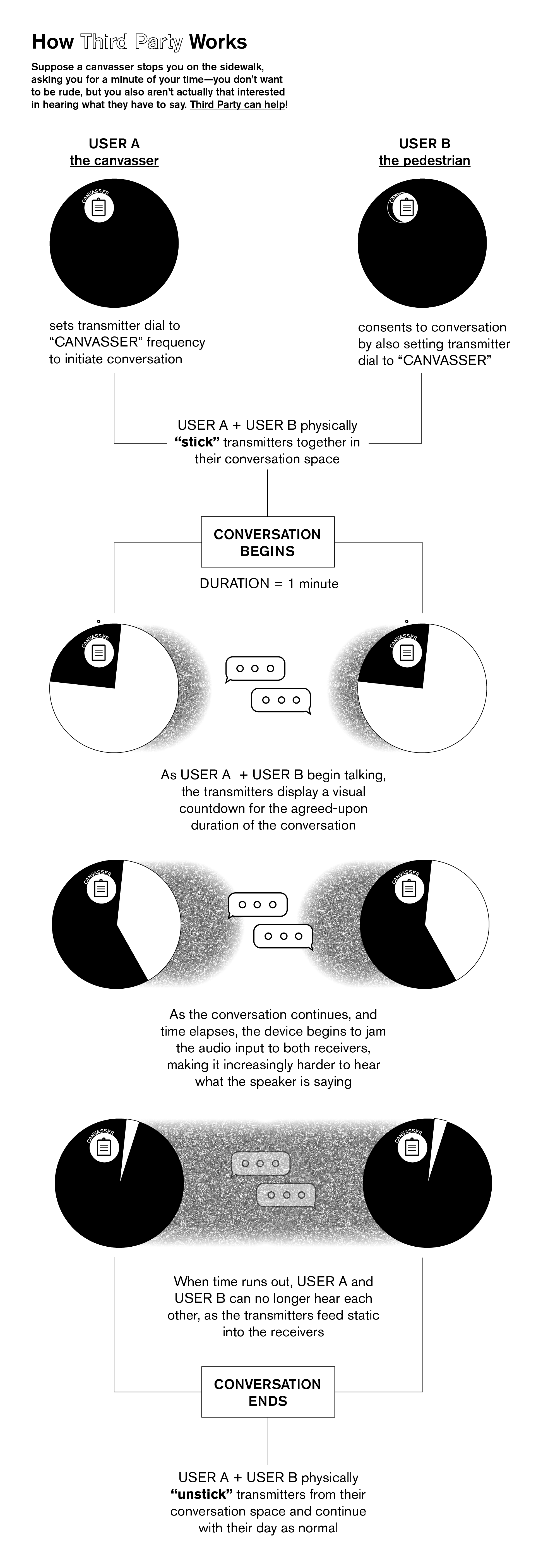
Third Party: Your IRL Social Mediator
Collaboration with: Nicci Yin2016 / 1-week project
CATEGORIES: UX, interaction, prototyping, speculative
KEYWORDS: human-computer interaction, mobile technology, social norms, social rituals IRL v. URL
My collaborator and I used lo-fi prototypes to create a speculative mobile device that explores social conventions around face-to-face conversations:
How can a mobile device help people to enter into (or exit) an IRL conversation?
PROJECT OVERVIEW
Third Party: Your IRL Social Mediator was designed in response to the idea of “stickiness” as a metaphor for designing tangible interactions. If a successful interaction is one in which the important things “stick” and the unimportant things “don’t stick”, then thinking of the different ways in which people and things “stick” to other people and other things can help us to generate new kinds of interactions.
This group project uses a combination of material research, user scenarios, and lo-fi prototypes to explore how “stickiness” can create new ways to connect (or disconnect) in the conversation space.


PROJECT OUTCOMES
Third Party is a speculative mobile device that explores social conventions around face-to-face conversations. It physicalizes the idea of "making a graceful exit" from awkward, compromising, or uninteresting social interactions.
Third Party can stick people together by filtering out surrounding noises and points of attention, focusing their attention on each other; it can also unstick by creating noise in between users and impairing their senses so that they cease to hear or see each other.

DEVICE PROTOTYPE
We created low-fidelity prototypes of Third Party with two components: the transmitter (a dialing pad) and receiver (an earpiece).
These devices are skeumorphs of rotary phones. We were inspired by the idea that "mobile devices" did not necessarily have to look like smartphones, and chose to look towards other forms of communication devices that afford interactions besides swiping and tapping.
Third Party borrows the rotate-to-dial interaction and the circular form of rotary phones; it also appropriates the action of tuning radio frequencies.



USER SCENARIOS
Conversations are not all the same—after brainstorming various types of undesirable conversations (e.g. being approached by someone on the street) but also desirable ones (e.g. talking to a crush), we designed three modes, or frequencies, for the device that use three different metrics:
CANVASSER
You’re walking down the street, and a canvasser comes up to you. You probably don’t have time to talk, but it would be pretty rude to ignore them, so you give them a minute even though you aren’t interested in donating to their cause. When the users tune into "canvasser," Third Party ensures that the conversation will actually last only one minute. As the (one-sided) conversation nears or exceeds its allotted time, the device jams the audio coming through the transmitters, making it impossible to hear what the other person is saying.
PARTY AQUAINTANCE
You’re at a friend’s party, and even though you don’t know that many people there, you came anyway for the free beer. You’re minding your own business, and somebody you don’t know very well strikes up a conversation with you. Their eagerness to “get-to-know-you” becomes overwhelming, and you realize that the two of you don’t have very much in common. Third Party registers when the conversation becomes one-sided, and jumbles your and your acquaintance’s voice input so that the conversation cannot physically continue.
BARISTA
You’re at your favorite coffee shop and have just ordered your favorite drink. The shop is starting to empty out and the cute barista is the one who is serving it up to you. If Third Party registers an increased heartbeat in both you and your barista, it allows you both to tune directly into what each other is saying, focusing the voice input so that the only thing both people can hear is each other.
INTERACTION + USER FLOW![]()
USER TESTING
Using our lo-fi prototypes as research probes, we tested with a group of users by:
- asking them to interact with the cardboard and velcro prototypes
- while projecting an animated video of what the transmitter would display (e.g. if this were on barista mode, the video would display the "heartbeat" metric).
- When the conversation ends, we would play white noise and static to simulate the effect of distortion.
This combination of analog and digital allowed the users to imagine the device as an actual working tool.
PROCESS
 ↳ Excerpts from preliminary material research and “no-technology” prototypes.
↳ Excerpts from preliminary material research and “no-technology” prototypes.

MATERIAL RESEARCH
Third Party was designed in reponse to the prompt of "Stickiness as metaphor"—using critical prototyping to explore the potential of metaphors for design. The project focuses on possibilities for novelty, affordance, meaning, and aesthetics of stickiness and data exchange and results in prototypes that use no technology.
Nicci and I looked at materials ranging from hair to gum to examine the different ways these materials can serve as design metaphors for data exchange. Our combined insights from these studies showed an interest in the process of data degradation, and of using biological processes (chewing) or materials (hair) to think about data exchange. The forms we used are also important—for instance, rather than neatly parceled cubes or points that data is often represented by (the gum perhaps comes the closest), we were more interested in fluffy, soft shapes like the marshmallows or indistinguishable, messy forms like hair.
Given our insights about the forms and processing of data, we focused our prototyping on conversations—an amorphous, messy, human material.
